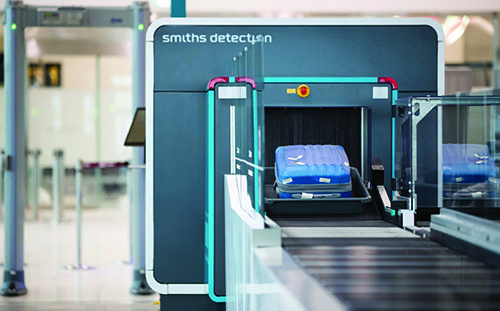The same high-tech scanning technology that’s used for medical imaging and screening checked baggage is gradually transitioning to passenger checkpoints at dozens of U.S. airports. As of mid-July, TSA had installed 123 computed tomography (CT) scanners at 41 airports around the country, with even more installations slated in coming years. The upgrade represents a considerable step forward in the technology used to screen passengers’ carry-on bags and other items.
The same high-tech scanning technology that’s used for medical imaging and screening checked baggage is gradually transitioning to passenger checkpoints at dozens of U.S. airports.
As of mid-July, TSA had installed 123 computed tomography (CT) scanners at 41 airports around the country, with even more installations slated in coming years. The upgrade represents a considerable step forward in the technology used to screen passengers’ carry-on bags and other items.
Specifically, security officials say that the improved scanners enhance threat detection, increase checkpoint throughput and significantly decrease false alarms. In addition to slowing down the screening process and inconveniencing passengers, false alarms increase the need for TSA officers to touch baggage (and items inside) during rechecks. So decreasing their frequency amid the COVID-19 pandemic is especially important.
|
facts&figures Project: CT Scanners for Carry-on Baggage Location: 41 U.S. airports Scanners Installed: CTiX, by Smiths Detection Installations to Date: 123 of 300 purchased Total Equipment Cost: Nearly $97 million Funding: TSA Timeline: Installations began in Dec. 2019 & are scheduled to continue for the next few years Key Benefits: Better threat detection; faster passenger throughput; reduced false alarms; electronics can remain in passengers’ bags; less contact between TSA officers & passengers due to remote operation; machines usually fit within existing checkpoint footprints & don’t require major renovations |
In March 2019, TSA awarded a nearly $97 million, five-year contract to Smiths Detection for 300 model CTiX scanners, plus associated ancillary equipment and services.
San Antonio International Airport (SAT) is one of several dozen airports already operating the new CT scanners. In mid-June, crews installed two at the Terminal B checkpoint and one at the Terminal A checkpoint. The Texas airport’s six other scanners utilize older multi-view X-ray technology that has been a staple at airports throughout the country for about the last 10 years.
 “The TSA asked if we wanted the new scanners installed, and we said yes,” says Jesus Saenz, director of airports for the San Antonio Airport System, which operates SAT and Stinson Municipal Airport. “They improve our overall security posture as passengers go through our security checkpoints. We expect all three scanners to be in full use by the end of summer.”
“The TSA asked if we wanted the new scanners installed, and we said yes,” says Jesus Saenz, director of airports for the San Antonio Airport System, which operates SAT and Stinson Municipal Airport. “They improve our overall security posture as passengers go through our security checkpoints. We expect all three scanners to be in full use by the end of summer.”
Beyond improving checkpoint efficiency, the new scanners at SAT and other select airports provide an especially timely benefit: fewer physical touch-points and less congestion at security lanes, which facilitates social distancing. Eventually, TSA officers will be able to view scanned images from a remote location, further minimizing their interaction with passengers.
Better Detection Capabilities
Advanced technology CT scanners make it easier for TSA officers to detect threats because they provide highly detailed, three-dimensional views of bags as opposed to the static, two-dimensional images that standard X-ray scanners produce. The new CT equipment also automatically identifies and visually highlights suspicious items.
TSA officers use a computer mouse or keypad to rotate images 360 degrees for better views. This makes it easier to find prohibited items, explains Jason Hull, a capability manager for accessible property at TSA.
Standard checkpoint technology uses a fixed projection X-ray that basically provides top and side views of each bag. In contrast, CT scanners employ a constantly rotating gantry that takes hundreds of pictures from many different angles, and then assembles them into a high-resolution three-dimensional image.
 This allows TSA officers to make much more accurate judgments about items in bags, because the technology can clearly differentiate between threats such as explosives and other similar but benign items, explains Shan Hood, president of Smiths Detection’s Americas business.
This allows TSA officers to make much more accurate judgments about items in bags, because the technology can clearly differentiate between threats such as explosives and other similar but benign items, explains Shan Hood, president of Smiths Detection’s Americas business.
Better images yield fewer false alarms and fewer bag rechecks, so throughput consequently increases, he adds.
Another benefit: The new scanners eliminate the need for passengers to remove laptops and other electronics from their carry-on bags. In the near future, that likely will apply to allowable liquids, too, Hull notes.
“Reduced manual baggage searches will help with COVID-19 because officers won’t have to go through as many passengers’ bags,” he adds. “This reduces the risks to both passengers and our officers.”
Hull says that even if people don’t move through checkpoints significantly faster than before, there’s no doubt the technologically advanced scanners will make the process more convenient.
Minimal Renovations Required
The CT scanners also can be integrated into automated checkpoint lanes. In these types of systems, which aren’t as common, passengers still manually place their items on trays for screening. But after bags are cleared and subsequently removed by passengers, an automated retrieval system moves the trays back to the beginning of the security checkpoint for re-use by other passengers waiting to be screened.
In most cases, the new scanners easily fit within existing checkpoint footprints and don’t require electrical upgrades, says Hood. As such, they can be installed with minimal disruption to ongoing operations.
Saenz reflects positively on the four-day installation at SAT. “The CT scanner is a little larger, but it’s pretty much a plug-and-play unit,” he relates.
“By and large, it appears that most major airports will not require any major renovations to use the new scanners,” says Hull.
Hood adds that the monitors and keyboards specified for the new CT equipment are very similar to those used with existing scanners, so they don’t present major changes or challenges for TSA officers. Furthermore, the scanners can be continuously upgraded with new software and detection algorithms. “We’re effectively future-proofing the machines,” he remarks.

Looking Ahead
 Why switch to CT technology now? Hull says the timing is good because existing X-ray scanners are nearing the end of their useful life cycles. In addition, many airport officials have been asking TSA for better screening technology that can detect more sophisticated emerging threats.
Why switch to CT technology now? Hull says the timing is good because existing X-ray scanners are nearing the end of their useful life cycles. In addition, many airport officials have been asking TSA for better screening technology that can detect more sophisticated emerging threats.
In addition, some traditional threats seem to be rising. For example, TSA statistics show that the ratio of guns detected to the number of passengers boarding planes has increased significantly.
From March 22 to April 22, TSA officers found 58 guns, compared to 346 during the same time period last year. Although the total number is down, when the figures are adjusted for the steep drop in passenger traffic related to the coronavirus pandemic, the recent rate is one gun for every 80,000 passengers screened. In 2019, the rate for the same period was one gun for every 216,200 people screened—a nearly three-fold jump.
More In Store
Hull notes that passengers might not experience significantly faster processing through checkpoints right away, because there’s always a learning curve when adopting new technology.
That has, in fact, been the case at SAT, where the new CT scanners are processing an average of about 100 bags per hour. But Saenz expects that figure to climb to 150 bags per hour when TSA officers become more proficient using the new scanners.
Currently, 41 airports have CT scanners operating at passenger checkpoints. (See sidebar to the left for full list.) During the next several years, however, TSA plans to install the new technology in about 100 airports nationwide.
“Overall, it’s a win-win situation—enhanced detection for TSA officers and faster processing time for passengers,” Saenz summarizes. “Passengers are very happy that they don’t have to remove electronics anymore. There are a lot more smiles on their faces because it’s easier for them.”
|
Airports with CT-Equipped Checkpoints Albany Int’l Airport (ALB) Albuquerque Int’l Sunport (ABQ) Augusta Regional Airport (AGS) Bill and Hillary Clinton National Airport (LIT) Birmingham-Shuttlesworth Int’l Airport (BHM) Bradley Int’l Airport (BDL) Charleston Int’l Airport (CHS) Charlotte Douglas Int’l Airport (CLT) Chicago O’Hare Int’l Airport (ORD)
Cincinnati/Northern Kentucky Int’l Dallas Fort Worth Int’l Airport (DFW) Daniel K. Inouye Int’l Airport (HNL)
Detroit Metropolitan Wayne County Dulles Int’l Airport (IAD) Greater Rochester Int’l Airport (ROC) Hartsfield Jackson Atlanta Int’l Airport (ATL) Jacksonville Int’l Airport (JAX) Kahului Airport (OGG) Lihue Airport (LIH) Los Angeles Int’l Airport (LAX) McCarran Int’l Airport (LAS) Memphis Int’l Airport (MEM) Minneapolis-St. Paul Int’l Airport (MSP) Newark Liberty Int’l Airport (EWR) Norfolk Int’l Airport (ORF) Palm Beach Int’l Airport (PBI) Philadelphia Int’l Airport (PHL) Phoenix Sky Harbor Airport (PHX) Portland Int’l Airport (PDX) Richmond Int’l Airport (RIC)
Ronald Reagan Washington National Sacramento Int’l Airport (SMF) St. Louis Lambert Int’l Airport (STL) San Antonio Int’l Airport (SAT) San Diego Int’l Airport (SAN) San Francisco Int’l Airport (SFO) Savannah/Hilton Head Int’l Airport (SAV) Southwest Florida Int’l Airport (RSW) Tampa Int’l Airport (TPA) Tulsa Int’l Airport (TUL) William P Hobby Airport (HOU) |



